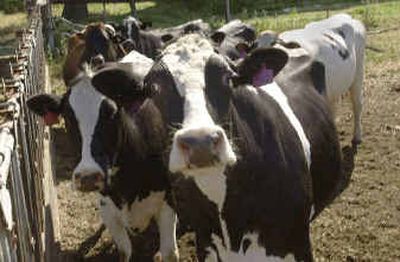Manure milked for all it’s worth

After 25 years of persistent work, Marin County, Calif., rancher Albert Straus has figured out a way to run his dairy farm, organic creamery and electric car from the manure generated by his herd of 270 cows.
Cheered on by a small gathering of engineers, environmentalists and fellow farmers, Straus stepped into a utility shed Thursday, switched on a 75-kilowatt generator, then stepped outside to snip the ribbon spanning a spanking-new electrical panel.
On the panel, an electricity meter began running backward, indicating that power originating from a nearby poop-filled lagoon near the town of Marshall, Calif., was feeding into Pacific Gas and Electric’s electric power grid.
“Well,” said Straus, with an understated shrug, “that was exciting.”
But for Straus, as well as for many of the spectators, switching on the farm’s new $280,000 methane digester system was not just a personal milestone — it signaled an environmental breakthrough for the state’s dairy industry.
While the technology for farm-based methane production has been around for two decades, economics and resistance from the utility industry have prevented all but a handful of California farmers from transforming their animal waste into energy.
While there are 1,950 commercial dairies in operation in California – which leads the nation in the production of milk and cheese – and nearly 2 million dairy cows, Straus’ methane digester is only the fifth now operating in the state.
But thanks to two pieces of recent legislation, 13 additional methane systems are now under construction, and renewable-energy advocates predict that scores more are sure to follow. The Straus project is the first of 14 methane projects to receive matching funds from the California Energy Commission, one result of the rolling blackouts that plagued the state during the summer of 2001.
“There was an emergency session (of the state Legislature) to create fixes to the energy problem,” said Mike Marsh, president of Western United Dairymen. “One thing they funded was renewable energy in the form of methane digesters.”
A $10 million pool of matching funds for farmers wishing to install methane digesters was created that year, followed in 2003 by a law allowing utilities to set up “net metering” agreements with small biogas generators.
With net metering, small producers like Straus can reduce or erase their energy bills but cannot be paid for pumping excess energy into the grid. Net metering has been available to owners of home solar systems for several years.
The Straus Farms’ covered-lagoon methane generator, powered by methane billowing off a covered pool of decomposing bovine waste, is expected to save the operation between $5,000 and $6,000 per month in energy costs. With those savings, Straus estimates he will pay back his capital investment in two to three years.
But the benefits go beyond the strictly financial. An innovator who converted his family’s dairy to organic a decade ago, Straus is a committed environmentalist who has worked for decades to make his operation clean, sustainable and environmentally friendly.
In addition to the energy savings, Straus’ new methane digester will eliminate tons of naturally occurring greenhouse gases and strip 80 to 99 percent of organic pollutants from the wastewater generated from his family’s 63-year-old dairy farm.
Heat from the generator warms thousands of gallons of water that may be used to clean farm facilities and to heat the manure lagoon. And wastewater left over after the methane is extracted, greatly deodorized, is used for fertilizing the farm’s fields.
“This is a great project, and I hope it will be replicated many times,” Straus said.
Transforming animal waste into a useful product potentially could solve some serious problems that accompany the dairy and livestock industries.
Despite their gentle demeanor and big brown eyes, dairy cows present some troubling environmental challenges. A well-fed dairy cow produces 120 pounds of manure every day, or 40,000 pounds per year per animal. Manure-laden farm runoff pollutes surface and groundwater with bacteria and nitrogen.
And then there’s the flatulence.
Researchers have estimated that a single cow can emit 100 to 200 liters of methane per day, not including the methane that continues to be generated as bacteria break down the mounds of manure.
This naturally occurring methane is a potent greenhouse gas, estimated to be 21 times as damaging to the ozone layer as carbon dioxide. The environmental benefits of transforming methane to energy are obvious. Even if the captured methane is simply burned off with a flare, the result is more environmentally friendly than letting the gas drift into the atmosphere.